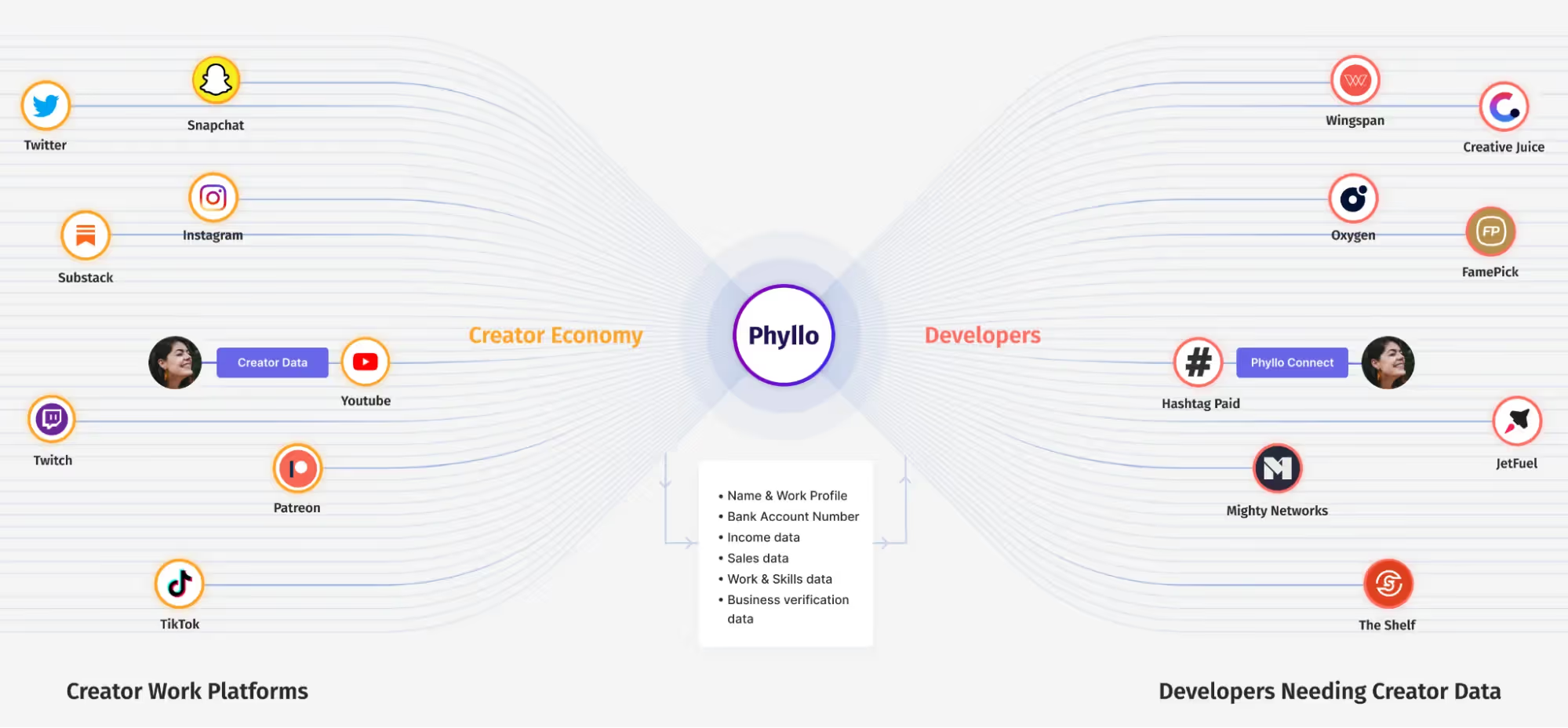Social media background checks are now a common part of hiring.
As more of our lives move online, employers are paying closer attention to what shows up on Instagram, LinkedIn, Twitter, and even TikTok, not just to spot red flags, but to understand who someone really is beyond the resume.
These checks help assess behavior, professionalism, cultural alignment, and public reputation, sometimes before an interview is even scheduled.
But there’s a fine line between screening for workplace fit and violating privacy. That’s where things get tricky and where compliance tools like Phyllo come in.
In this guide, we’ll break down what social media background checks involve, how employers use them, the legal rules around them (U.S. and global), and how to handle the process in a way that’s fair to both sides.
Let’s get into it.
TL;DR Summary
Social media background checks are now part of the hiring playbook. Employers often scan public profiles to spot red flags, assess cultural fit, and understand how a candidate presents themselves online.
These checks can involve anything from LinkedIn posts to TikTok videos. But while helpful, they raise important legal and ethical questions, especially around privacy and bias.
What Is a Social Media Background Check? (Definition + Examples)
A social media background check is when employers review a candidate’s public online profiles to learn more about their behavior, values, and how they engage with others. It helps hiring teams spot any signs of risk, assess cultural fit, and get a fuller picture beyond the resume, based on real interactions on platforms like LinkedIn, Instagram, or X.

Think of it as the HR equivalent of scrolling through someone’s Instagram before going on a first date, but with legal consequences.
Employers don’t do this just to poke around. There are real, practical reasons behind it:
- Reputation Management: Companies want to know that you won’t go viral for the wrong reasons.
- Cultural Fit: A person’s online presence can reflect their communication style, interests, and even values.
- Risk Mitigation: Red flags like hate speech, threats, illegal activity, or public harassment are major concerns, and companies don’t want those issues walking in the front door.
In a typical social media background check, employers often review multiple platforms for different insights:
- LinkedIn – to assess professional tone, qualifications, endorsements, and mutual connections.
- Facebook – for personal views, group affiliations, and overall digital behavior.
- X /Twitter– to measure unfiltered opinions, public interactions, and communication style.
- Instagram – to observe lifestyle choices, visual content, and caption tone.
- TikTok – yes, even dance trends and comment history can give HR a glimpse into personality and public presence.
These checks can reveal a lot, from leadership qualities and social responsibility.
But wait for a second.
“Do employers seriously check the social media of employees before and after hiring?”
That’s the exact question one Redditor asked, and the response from someone with actual hiring experience was kind of eye-opening:

So, yes. This matters, and it’s not about judging your brunch pics. It’s about protecting the company (and honestly, your own credibility).
Why Do Employers Check Social Media Before Hiring?
The internet might forget your birthday, but it won’t forget that tweet from 2012.
Employers are paying attention. As people share more of themselves online, what used to be private is now public record. That makes social media a powerful lens during the hiring process.
Everyone Leaves Digital Clues
What someone posts or engages with offers a peek into how they think, behave, and communicate. For roles that involve public interaction, creative work, or leadership, this can carry real weight.
A profile filled with arguments, controversial comments, or angry rants might raise flags.
On the other hand, content showcasing volunteer work, industry insights, or thoughtful opinions might have the opposite effect.
Examples of Social Media Posts That Got Employees Fired
These are not just exemplary tales. They’ve actually happened.
1. Liking a LinkedIn Post Led to a Dismissal
In a case covered by The Times of India, an employee lost their job after liking a post that called out management practices. The like was interpreted as public agreement.
The company saw it as disloyalty.
No comments, no post, just a tap on a heart icon.
2. Fired After Facebook Post About Trump
In a Reddit post, a user described how their coworker was fired after posting on Facebook that he wished “better gunmen would go after Trump.”
Someone saw it, reported it, and within hours, he was out of a job. No second chances, just a formal meeting, then a walk to his desk to collect his things.

Even though the message was not direct, the consequences were.
Is It Legal to Check a Candidate’s Social Media? (Rules & Employer Boundaries)
Social media is public, but that doesn’t mean employers can do whatever they want with it.
There’s a legal line between gathering useful insight and violating someone’s rights. Employers must tread carefully to avoid discrimination, privacy breaches, or lawsuits.
Here’s a breakdown of what’s generally allowed and what’s off-limits:
These are the key legal considerations outlining what employers can and cannot do during a social media background check.
Global Legal Frameworks for Social Media Checks
1. European Union – GDPR
Employers must have a lawful basis for collecting and processing social data. Checks must be necessary for the job, and candidates must be informed. Data privacy, security, and rights to access/rectify/delete data are strictly enforced.
2. Canada
Canada follows principles similar to GDPR. Employers must obtain meaningful consent and ensure social data usage is limited to job relevance.
3. Australia
Under the Privacy Act, online data is considered personal information. Employers must protect this data and use it only in ways that are fair and lawful.
4. India
While India doesn’t yet have a comprehensive privacy law like GDPR, employers are still bound by IT and employment rules when handling sensitive content or workplace-related digital behavior.
How Do Employers Perform Social Media Background Checks?
Now that we’ve covered the “why” and the legal side of things, let’s get into the “how.”
Employers generally take one of two routes: they either check profiles manually or use software to do the heavy lifting. Each has its pros, and each comes with trade-offs.
Let’s quickly understand this.
Manual Review (In-house HR)
This approach is pretty straightforward. A recruiter or HR team member pulls up a candidate’s public social profiles and scrolls through their recent activity.
No fancy tools, just some searching, some reading, and sometimes, a lot of guessing.
Pros:
- Human context: Reviewers can understand tone, sarcasm, and intent better than machines.
- Full control: You decide what matters and what doesn’t based on your company’s culture.
Cons:
- Bias: It’s hard not to let personal opinions sneak in, especially when you’re seeing vacation pics, family photos, or political rants.
- Inconsistency: One recruiter might overlook a joke; another might flag it.
- Time-consuming: Reviewing multiple platforms for every candidate takes effort and attention.
Automated Review (Third-party Services)
With automated tools, the process becomes more structured.
These platforms scan publicly available content and flag posts based on preset criteria, like hate speech, illegal activity, or threats. Some even assign risk scores or organize results in dashboards.
Pros:
- Faster and scalable: You can screen more candidates in less time.
- Reduced bias (when properly configured): The software doesn’t care about someone's favorite football team or music taste.
- Better documentation: Most platforms store audit trails and reports automatically.
Cons:
- Lack of nuance: A sarcastic tweet might be flagged the same way as an actual threat.
- False positives: Context is everything, and machines often miss it.
- Cost: Reliable services often come at a premium.
While we won’t list products here, many employers use third-party tools built specifically for HR compliance.
These platforms often integrate with applicant tracking systems (ATS) and allow companies to maintain structured, legal, and consent-based workflows.
Some employers even build internal tools or scripts to automate parts of the review, but these come with their own challenges, especially around privacy and legal compliance.
What Do Employers Look For on Social Media Profiles?
Employers assess candidate alignment through behavior patterns, not just for red flags but also for cultural fit indicators.
Social Media Red Flags That Can Hurt Your Job Application
Let’s start with the obvious ones.
These are the types of posts that can land someone in serious trouble, especially in industries with strict policies or public-facing roles:
- Illegal activity, like references to drug use, violence, or criminal conduct
- Harassment or bullying, even in a joking tone
- Threats, no matter how sarcastic they seem
- Breaches of confidentiality, like sharing company secrets or client data
Even one of these can be enough to raise questions, especially if the role involves leadership, public interaction, or working with vulnerable communities.
Cultural Fit Indicators
Not everything is about catching someone doing something wrong.
In fact, many companies also look for posts that align with their mission, tone, or values.
These might include:
- Volunteering or advocacy work, especially in causes the company supports
- Mentorship or speaking engagements in relevant fields
- Posts about collaboration, team wins, or learning moments
- Respectful engagement in comment sections, no trolling, even in heated topics
These give a glimpse into how someone behaves outside the interview room.
What Neutral or Safe Social Media Behavior Looks Like
Sometimes, nothing stands out, and that’s not a bad thing.
Profiles that show regular day-to-day updates, personal hobbies, and low-conflict engagement are often viewed as a green flag by default.
In short, no one’s expecting perfection.
But they are looking for consistency between how you present yourself during the hiring process and how you behave online. The gap between the two is where trust is either built or lost.
How Phyllo Helps Employers Conduct Ethical Social Media Screening
First, look at Phyllo
By this point, it’s clear why social media checks are becoming standard.
But the how matters just as much as the why. That’s where tools like Phyllo come in, helping employers walk the line between smart screening and overreach.
What Is Phyllo and Why Does It Matter?

Phyllo is a unified API platform that gives real-time access to social data, but only the data that candidates explicitly agree to share.
Instead of scraping public content or skimming through profiles manually, Phyllo lets users connect their platforms (like YouTube, Instagram, Twitter, or TikTok) and share selected data points directly with employers or platforms.
This creates a transparent process with two major benefits:
- It ensures consent is front and center. Nothing gets accessed unless the user clicks “yes.”
- It guarantees authenticity. The data comes straight from the source, not screenshots or secondhand edits.
That combination makes it both ethical and legally defensible.
Phyllo’s Consent Workflow for Legal & Transparent Screening
Phyllo makes things simpler by embedding transparency and compliance into the workflow:
- Built-in consent process: Candidates authorize access just like signing into a platform with Google or Facebook.
- No scraping, no guesswork: Everything comes through a secure, permitted channel.
- Fits inside your existing stack: Whether you use an ATS or a custom HR tool, Phyllo can plug in without a mess of custom code.
This means legal teams are not left scrambling to document how a hiring decision was made, and candidates are not left in the dark about what was reviewed.
Who Should Use Social Media Screening Tools Like Phyllo?
Phyllo is especially useful for roles where a candidate’s online activity is core to the job:
- Hiring a social media manager or content creator? You’ll want to see portfolio posts, reach metrics, and public interactions.
- Looking for a brand ambassador or customer-facing rep? Reviewing tone and communication style is part of the fit.
- Screening for fraud or impersonation? Phyllo’s real-time connection avoids relying on screenshots that might be outdated or faked.
Instead of trying to "dig up dirt," you’re creating a documented, transparent exchange that respects boundaries and keeps your hiring clean.
Improve Hiring with Consent-Based Social Media Checks
Social media offers more than just a highlight reel; it gives real insight into how candidates engage, express themselves, and align with your values.
However, most background checks depend on screenshots, assumptions, or invasive scraping techniques. That’s where our tool changes the game. With real-time, consent-based access to social data, you get a clear, ethical view without crossing boundaries.
It's a smarter way to screen, one that respects privacy, ensures compliance, and helps you hire with confidence.
Try Phyllo today and simplify social media checks with the compliance-first approach your hiring team needs.
FAQ
1. Can I reject a candidate based on social media posts?
Yes, but only if the content directly violates your documented workplace standards, such as promoting violence or illegal activity. Decisions must be tied to job-relevant concerns.
2. Do I need their consent to check their online profiles?
If you're using third-party screening tools or generating reports as part of your hiring process, then yes, under laws like the FCRA, consent is mandatory.
3. What if I find content that violates company values but is not illegal?
You can flag such content, but decisions must be consistent and defensible. Make sure your policies clearly define what qualifies as a values-based concern.









